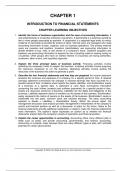Exam (elaborations)
Test Bank for Financial Accounting Tools For Business Decision Making 10th Edition Paul D. Kimmel, Jerry J. Weygandt, Jill E. Mitchell 2024 | A+
- Course
- Institution
Test Bank for Financial Accounting Tools For Business Decision Making 10th Edition Paul D. Kimmel, Jerry J. Weygandt, Jill E. Mitchell 2024 | A+ CHAPTER 1 INTRODUCTION TO FINANCIAL STATEMENTS CHAPTER LEARNING OBJECTIVES 1. Identify the forms of business organization and the uses of accounting i...
[Show more]



